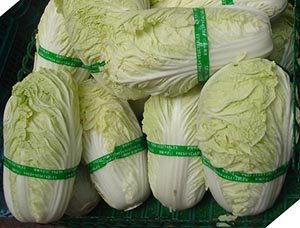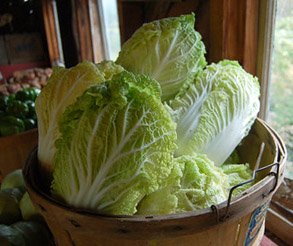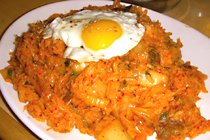Napa Cabbage (Chinese Cabbage) Nutrition Facts
Napa cabbage, alongside bok choy, is one of the favorite leafy cabbage varieties in mainland China. The sweet, crunchy, and celery-flavored leaves of Napa are highly prized in Far East-Asian cuisine. Indeed, Chinese cabbages are increasingly finding their way into Western, Mediterranean, and American dishes due to their nutritious profile.
Botanically, this variety belongs to the Brassica family, a diverse group of leafy and flowering vegetables that includes Brussels sprouts, kale, cabbage, and broccoli, among others.
Its scientific name is B. campestris (Pekinensis group). Napa cabbage goes by several common names, such as pe-tsai, 白菜, celery cabbage, Chinese white cabbage (dàbácài, 大白菜), Peking cabbage, won bok (wombok), napa (Japanese), hakusai (白菜, Japanese), pao, hsin pei tsai, kimchi cabbage, and more.
 |
| Fresh napa-cabbage. Photo courtesy: mdid |
Napa cabbage is an annual cool-season vegetable that flourishes in short, temperate days. Resembling traditional cabbages, it develops rounded heads comprising densely packed, crinkled, light-green leaves accentuated by distinct pale white veins. The inner leaves boast a smooth, light-yellow coloration.
 |
| Napa cabbage. Photo courtesy: Ilovebutter |
Two main types of Napa cabbage exist: Chilili and Che foo. Chilili varieties yield elongated heads, usually about 18 inches in length and 6 inches in width, growing upright in a cylindrical shape. On the other hand, Che-foo variations develop dense, spherical heads composed of green leaves accented by white petioles.
Health benefits of Napa (Chinese) Cabbage
Napa cabbage stands out as an incredibly low-calorie green-leafy vegetable, with just 16 calories per 100 g of fresh leaves. Alongside celery, bok-choy, and others, it easily aligns with the neo-class of zero-calorie or negative-calorie vegetables often recommended by dieticians.
Napa is rich in antioxidant plant compounds like carotenes, thiocyanates, indole-3-carbinol, lutein, zeaxanthin, sulforaphane, and isothiocyanates. It also provides a significant amount of soluble and insoluble dietary fiber. Scientific research suggests that these compounds can protect against breast, colon, and prostate cancers and help lower LDL or "bad cholesterol" levels.
Fresh napa cabbage is an excellent source of folates, offering 79 µg or 20% of the daily required levels of this B-complex vitamin per 100 g. Folates are essential for DNA components, and adequate intake during pregnancy may help prevent neurological diseases in newborns.
Napa cabbage boasts high levels of vitamin C, providing about 45% of the daily requirements per 100 g. Regular consumption of vitamin C-rich foods aids in developing resistance against infections and scavenging harmful free radicals.
Similar to other cabbages, napa contains moderate levels of vitamin K, offering around 38% of the recommended daily allowance. Vitamin K plays a vital role in bone metabolism by promoting osteoblastic activity and may help delay osteoporosis. Additionally, it may contribute to treating Alzheimer's disease by limiting neuronal damage.
While napa cabbage has modest levels of vitamin A, it contains flavonoid polyphenolic compounds such as carotenes, lutein, and xanthin, which are converted to vitamin A in the body.
Like other green vegetables, napa is a good source of essential vitamins such as riboflavin, pantothenic acid, pyridoxine (185 of RDA), and thiamin, which are necessary for replenishing the body's requirements.
Napa cabbage serves as a natural source of electrolytes and minerals like calcium, potassium, phosphorus, manganese, iron, and magnesium. Potassium regulates heart rate and blood pressure, manganese acts as a co-factor for antioxidant enzymes (superoxide dismutase), and iron is vital for red blood cell formation.
| Principle | Nutrient Value | Percent of RDA |
|---|---|---|
| Energy | 16 Kcal | <1% |
| Carbohydrates | 3.23 g | 2.50% |
| Protein | 1.2 g | 2% |
| Total Fat | 0.32 g | 1% |
| Cholesterol | 0 mg | 0% |
| Dietary Fiber | 1.2 g | 3% |
| Vitamins | ||
| Folates | 79 µg | 20% |
| Niacin | 0.400 mg | 2.50% |
| Pantothenic acid | 0.105 mg | 2% |
| Pyridoxine | 0.232 mg | 18% |
| Riboflavin | 0.050 mg | 4% |
| Thiamin | 0.040 mg | 3% |
| Vitamin A | 318 IU | 11% |
| Vitamin C | 27 mg | 45% |
| Vitamin K | 42.9 mcg | 38% |
| Vitamin K | 2.2µg | 2% |
| Electrolytes | ||
| Sodium | 8 mg | 0.5% |
| Potassium | 238 mg | 5% |
| Minerals | ||
| Calcium | 77 mg | 8% |
| Iron | 0.31 mg | 4% |
| Magnesium | 13 mg | 3% |
| Manganese | 0.190 mg | 8% |
| Phosphorus | 29 mg | 4% |
| Zinc | 0.23 mg | 2% |
| Phyto-nutrients | ||
| Carotene-ß | 150 µg | -- |
| Carotene-α | 1 µg | -- |
| Lutein-zeaxanthin | 48 µg | -- |
Selection and storage
Leafy greens such as Napa cabbage are susceptible to pests. Conventionally grown Napa cabbage may have been treated with insecticidal sprays. Therefore, it is essential to thoroughly wash them in cold running water, followed by soaking them in saline water for approximately 30 minutes. Rinse them again in clean water before cooking.
When purchasing from the grocery store, seek out fresh, crispy, and compact Napa cabbage. Avoid those with yellow, dry, worm-infested, or old stalks.
At home, store Napa cabbage similarly to other greens, inside the refrigerator set at high relative humidity. It is optimal to use it while still farm-fresh to preserve maximum nutrients.
Preparation and serving tips
To begin, trim the base of the vegetable and discard any outer, discolored leaves. Submerge the entire vegetable in cold water and wash it thoroughly. After washing, either gently pat it dry or let it drain upside down until all the water has drained out.
For preparation, trim the base with a paring knife and then use your hands to separate the leaves from the stalk. Once the leaves are detached, they can be utilized in various recipes, either combined or individually.
In Far-Eastern regions, the average person consumes approximately a pound of fresh leafy-cabbage class vegetables daily, whether in the form of raw greens, in stews, or pickled (kimchi).
Here are some of the preparation tips:

|
| Korean kimchi fried rice! Photo courtesy: LWY |
Sweet, crunchy, and flavorful Chinese cabbage can be enjoyed raw and added to salads, sandwiches, and burgers.
Similar to other cabbage varieties, napa cabbage can also be used to make coleslaw.
Napa cabbage, also known as "pe-tsai," is a popular ingredient in Korean fermented dish, kimchi.
In Thailand and other East Asian countries, shredded napa cabbage is steamed with rice wrapped in plantain leaves and served alongside stews.
In China and other East Asian regions, it is utilized similarly to cabbage in stir-fries, combined with onion, garlic, bell pepper and green chilies. This mixture is often paired with steamed rice and sauces like soy, chili, or tomato to create dishes such as fried rice, egg rice noodles, or chow mein.
Both bok choy and napa cabbage are versatile vegetables commonly used in modern stir-fries, soups, and stuffing.
Safety profile
Just like other vegetables belonging to the Brassica family, Napa cabbage contains specific chemical compounds referred to as "goitrogens." Continual intake of vegetables from the Brassica group might cause enlargement of the thyroid gland, a condition termed goiter. Hence, it's recommended to restrict Brassica vegetables in the diet of individuals with thyroid issues. Nonetheless, they pose no concerns for consumption by healthy individuals. (Medical disclaimer).
You may also like to read ≻≻
≺≺ Mizuna Nutrition facts.
≺≺ Komatsuna Health benefits.
≺≺ Chinese broccoli (Gai lan) Health benefits.
≺≺ Tatsoi (spoon mustard) Health benefits.
≺≺ Mustard-greens Health benefits.
≻≻-Back to Vegetables from Napa cabbage. Visit here for an impressive list of vegetables with complete illustrations of their nutrition facts and health benefits.
≻≻-Back to Home page.
Further reading:
Stanford School of Medicine Cancer information Page- Nutrition to Reduce Cancer Risk. (Link opens in new window).